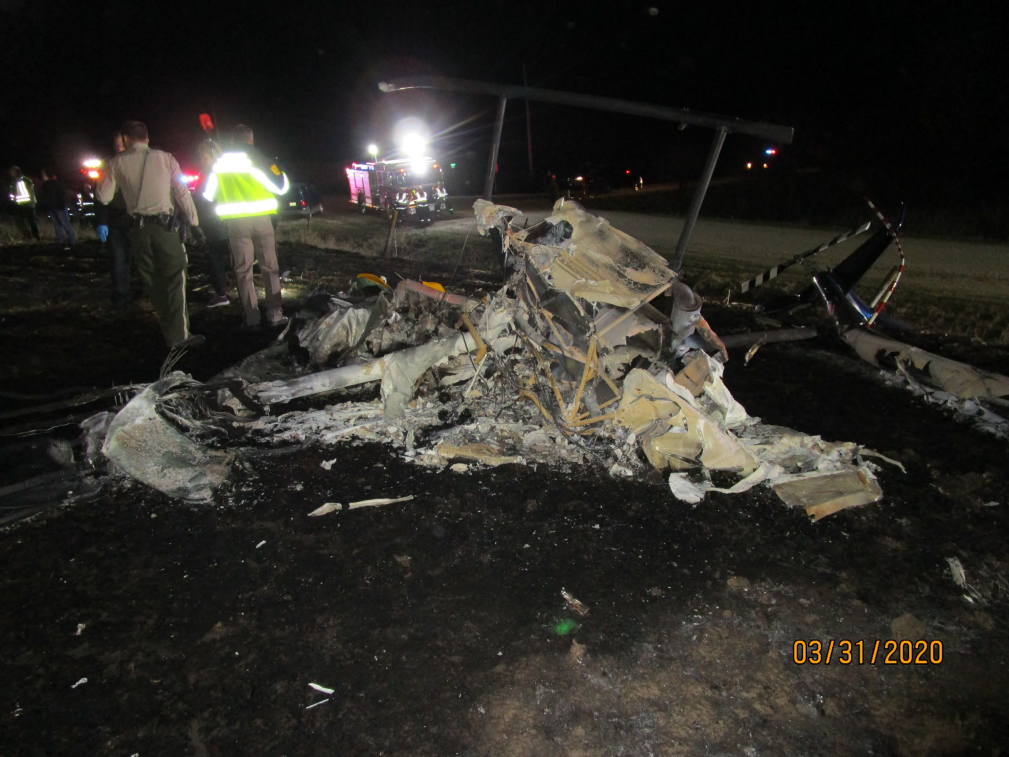
ASN Wikibase Occurrence # 234611
This information is added by users of ASN. Neither ASN nor the Flight Safety Foundation are responsible for the completeness or correctness of this information.
If you feel this information is incomplete or incorrect, you can submit corrected information.
| Date: | Tuesday 31 March 2020 |
| Time: | 16:30 LT |
| Type: |  Robinson R44 Raven II |
| Owner/operator: | MN Helicopters Inc |
| Registration: | N107EH |
| MSN: | 10423 |
| Year of manufacture: | 2004 |
| Total airframe hrs: | 1906 hours |
| Engine model: | Lycoming IO-540-AE1A5 |
| Fatalities: | Fatalities: 2 / Occupants: 2 |
| Aircraft damage: | Destroyed |
| Category: | Accident |
| Location: | Audubon, IA -
 United States of America United States of America
|
| Phase: | En route |
| Nature: | Survey |
| Departure airport: | Carroll Airport, IA (CIN/KCIN) |
| Audubon, IA | |
| Investigating agency: | NTSB |
| Confidence Rating: |
The pilot and passenger were conducting a low-altitude raptor survey flight. Witnesses reported seeing the helicopter flying just prior to its impact with powerlines about 85 ft above the ground. The witnesses described the helicopter in a gentle turn toward the sun prior to impact. One witness noted that he did not hear any unusual noises from the helicopter prior to impact.
Automatic dependent surveillance-broadcast data from the helicopter provided information indicating the pilot flew six flights in the 24 hours prior to the accident. The accident flight was the fifth that day and occurred approximately 10 hours after the pilot had begun flying that morning. Intervals between flights that day were 17, 24, 35, and 29 minutes.
These working conditions were conducive to fatigue. Research on pilot fatigue in a noisy, vibrating helicopter simulator found considerable increases in subjective fatigue after 6 hours of short repetitive flights. At the end of this period, some helicopter pilots who participated in the study said they were so fatigued that they did not feel safe to fly a real helicopter. As subjective fatigue increased, study pilots demonstrated increasingly frequent “lapses” in performance.
While missions the day of the accident were longer than those in the study, flights were conducted at low altitude and involved repetitive observation tasks that required a high state of awareness to avoid terrain and obstacles. This heightened state of awareness would produce a mental workload similar to the shorter repetitive IFR flights in the study; therefore, it is likely that similar effects would be expected, including lapses in performance as fatigue increased. These lapses in performance were described in the study as outliers caused by moments of inattention. The accident pilot’s ability to avoid the same wire nine times earlier that day, but not avoid it during the accident flight is consistent with an attentional “lapse.” This potential lapse combined with over 10 hours since awakening, and 8 hours flight time already accumulated the day of the accident suggests that the pilot was likely fatigued during the accident flight and that fatigue likely challenged the pilot’s ability to see and avoid the power line.
Probable Cause: The pilot’s failure to recognize and avoid the power line during the low-altitude flight. Contributing to the accident was the pilot’s fatigue, which affected the pilot’s ability to see and avoid the power line.
Accident investigation:
 |
|
Sources:
https://www.kcci.com/article/developing-witness-reports-helicopter-crash-in-rural-audubon-county/31998033
http://www.swiowanewssource.com/audubon/news/article_bd47f36e-2451-5c3c-9f7c-03b03d1714d1.html
https://www.startribune.com/2-minnesotans-die-in-fiery-western-iowa-helicopter-crash/569287542/
NTSB
FAA
https://registry.faa.gov/aircraftinquiry/NNum_Results.aspx?NNumbertxt=107EH
https://s3.amazonaws.com/mfbimages/logbook/images/aircraft/id/105011/2018072815402221-3819334_.jpg (photo)
Location
Images:

Photo(c): NTSB
Media:
The NTSB is investigating the March 31 crash of a Robinson R-44 helicopter in Audubon, Iowa. The NTSB is not traveling to the scene of the crash at this time.
— NTSB_Newsroom (@NTSB_Newsroom) April 1, 2020
Two people were killed in a helicopter crash in Audubon County Tuesday afternoon. https://t.co/m3Ep2NJeKG
— WHO-HD Ch. 13 News (@WHOhd) April 1, 2020
Two people were killed in a helicopter crash near Audubon in western Iowa on Tuesday, according to the Federal Aviation Administration. https://t.co/AkyC9tsBqQ
— KCRG (@KCRG) April 1, 2020
Revision history:
| Date/time | Contributor | Updates |
|---|---|---|
| 01-Apr-2020 08:08 | gerard57 | Added |
| 01-Apr-2020 13:46 | Aerossurance | Updated [Time, Aircraft type, Location, Embed code] |
| 01-Apr-2020 14:12 | Captain Adam | Updated [Total fatalities, Total occupants, Other fatalities, Phase, Nature, Source, Embed code, Narrative] |
| 01-Apr-2020 14:33 | Captain Adam | Updated [Registration, Phase, Source, Narrative] |
| 01-Apr-2020 15:50 | Anon. | Updated [Registration] |
| 01-Apr-2020 15:52 | harro | Updated [Narrative] |
| 01-Apr-2020 16:09 | Aerossurance | Updated [Narrative] |
| 02-Apr-2020 06:47 | Iceman 29 | Updated [Source, Embed code] |
| 02-Apr-2020 06:48 | Iceman 29 | Updated [Embed code] |
| 02-Apr-2020 16:35 | RobertMB | Updated [Aircraft type, Cn, Operator, Source, Embed code, Narrative] |
| 02-Apr-2020 16:36 | A.J.Scholten | Updated [Source] |
| 10-Feb-2022 19:25 | Aerossurance | Updated [Source, Narrative] |
| 16-Mar-2022 19:03 | Captain Adam | Updated [Nature, Departure airport, Destination airport, Source, Narrative, Category, Accident report, Photo] |
Corrections or additions? ... Edit this accident description
The Aviation Safety Network is an exclusive service provided by:


 ©2024 Flight Safety Foundation
©2024 Flight Safety Foundation